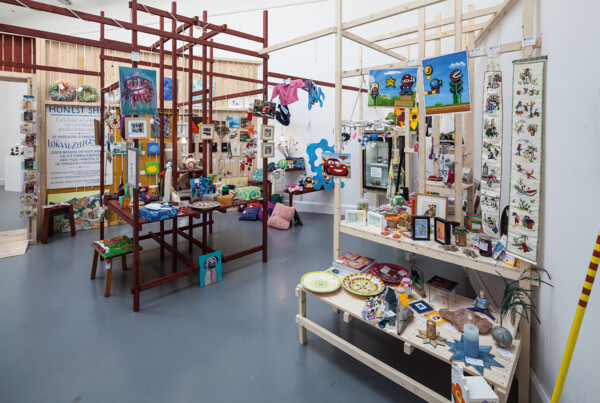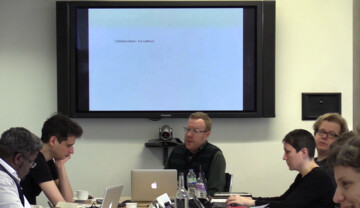Constituencies are fluid, mutable, protean. They grow, change, adapt, hybrid and reform according to circumstance and need. As such constituencies, as well the status of being constituent, are always in the process of both becoming and unbecoming – constituencies result from a process of social production whose medium and the vehicle is, of necessity, collaborative. The etymological root of collaboration (from the late Latin collaborare – meaning co-labour) is crucial here. This notion of collaboration as shared or co-labour, and of labour as a socially produced resource, offers us the means to both re-imagine the kind of work, or labour, that the work of art has now become, and the role and function that the museum of the future could play within this reimagining. It is the organic and piecemeal nature of collaboration which allows us to do this. Collaboration is, by its very nature, dialectical. It provides us a tool by which we can re-approach and renegotiate history on behalf of constituency whilst, at the same time, it also allows us a way to think beyond the structural impositions, failed narratives and hierarchical inequalities of democracy today.
For example, in his recent book The Uprising: On Poetry and Finance[1], theorist and activist Franco Berardi argues that the radical deregulation of neoliberal capital is predicated upon the increasing abstraction of language from the body. Deregulatory logic, he suggests, relies on the possibility of endlessly connecting and re-configuring language into regulated, recombinable and meaningless components. This, he argues, runs counter to the open, porous, and poetic use of language as a fluid form of conjunction – as an endlessly open means of understanding ourselves and each other through evolving forms of communication and growth. In light of this, Berardi proposes that the new job of the artist or poet is to return non-alienated forms of porous, mutable and productive language to the physical and social body. In doing so, and perhaps more importantly, Berardi also allow us to replay the concomitant bifurcation that Marx began to open up at the beginning of Kapital Volume 1 – between an ethical and qualitative valorisation of bodily → labour (as use-value, as the necessity to produce and reproduce the material means of reproduction) and the abstract, quantitative and instrumentalising mechanisms of exchange-value.
At first glance, Berardi may seem to be offering us little more here than the possibility of romanticising the essentialist activity of labour itself (through the act of returning a messy and conjunctive use of language to the body as some kind of ethical rebuff to the dehumanising consequences of connective, instrumental and regulatory capitalism). However, I would argue that just such an insistence on the collaborative production of labour (of labour as a necessary form of social production and reproduction of the means of subsistence, as something which is activated through the very mechanisms of collaboration and constituency) is essential if we are to think and act beyond our current impasse. If this is the case, then collaborative and constituent uses of language would provide us with the means to challenge the established status quo of economic predicates and determinates through the material production of new social meanings and new autonomies.
However, to bring us sharply back to the realities of our present cultural condition, we might also ask what happens to the role and function of the work (or labour) of art when, as Berardi has also argued[2], the hallmarks of modernist avant-garde resistance have long since been co-opted by the rhetorics of financial capitalism and, more specifically, by the economically driven model of the culture industries. If this is the case, then artists, or for that matter art institutions, which see themselves as progressive progenitors of artistic possibility, can no longer simply reach out to the well-rehearsed mantras of artistic autonomy and cultural alterity. As both left and right increasingly occupy the same territory of rhetorical discourse surrounding freedom and community, the implications for our traditional understandings of the work or labour of art would appear to be stark. Furthermore, this present condition of the increasing “capture” of the work or labour of art by a seemingly all pervasive and predatory deregulatory logic has, in its turn, some radical (and perhaps not entirely expected) implications for our understanding and use of 1:1 scale, long-term and socially embedded art projects. This is particularly important if, as Stephen Wright has argued, we are prepared to engage with the complexities of 1:1 scale art practices as containing within them the possibility of a double ontological status (as being able to function, simultaneously, as both artwork and something else – be it a restaurant, an activist cell, a rumour on Twitter, or whatever else).[3]
For example, if we allow ourselves to agree with Wright, then the double ontological status of 1:1 scale art perhaps offers us a line of flight from our current condition – a condition that continues to raise the problematic issue of how to be socially active and engaged without, at the same time, inadvertently subscribing to the deregulatory logic of globalised neoliberalism (and, unfortunately, the task of escaping the gravitational pull of Big Society – as the Conservative UK Prime Minister David Cameron put it – is one that is far more protracted and complex than simply declaring oneself to be alternative or oppositional). Furthermore, this question, or rather conundrum, now cuts to the very core of what it might mean to be radical and alternative, and also the point at which new forms of relational or constituent museums and galleries might imagine themselves as having a key role to play in the imagination of new and oppositional forms of identity and citizenship. If, for example, we accept the argument that traditional forms of radical activity have themselves become so successfully occupied by the deregulatory logic of neoliberal commodification then, as Zdenka Badovinac argues in her recent article Using Art as Art: How to Emancipate Work Through Art,[4] then art, artworks and the museum/gallery space could, once again, begin to provide an identifiable space in which to offer, evolve and share true possibilities for thinking ourselves through and beyond this most complex of impasses.

The Museum of Arte Útil, exhibition view, initiated by Tania Bruguera, 7 December – 30 March 2014, Van Abbemuseum. Photo: Perry van Duijnhoven.
Whilst this argument does, in itself, seem compelling – as do recent radical attempts to physically and ideologically re-imagine the role, function and purpose of art, artworks and their use by audiences (such as the Van Abbemuseum’s The Museum of Arte Útil (Figure) and the Asociacion of Arte Útil as a network of ongoing, durational and 1:1 practices initiated by the artist Tania Bruguera) – the shift implied by such thinking would, in itself, engender the radical re-thinking, and physical re-distribution, of the organisational and curatorial power structures which currently underpin our neo-Kantian paradigms of modernist exhibition and display. Putting this another way, we cannot simply expect to escape the gravitational pull of neoliberal logic by taking an apolitical refuge within the now bankrupt ideological safe-haven of the → autonomous modernist gallery space – however we may adapt this to the display, commodification and spectacularisation of 1:1 projects which function more effectively in the “real world”. Instead, we would have to imagine the future of art as a collaborative and constituently produced process of co-labour between the two intertwined halves of art’s double, and dialectical, ontological status.
On the one hand, let us say on the level of art’s double ontological status as art, this must happen on the level of production, curation and display. As Badovinac succinctly puts it, “curators as well as artists must renounce our ambition to have total knowledge and control of our projects, for only in this way is it possible to consider 1:1 art and the presentation of 1:1 art outside the traditional roles of art and exhibition-making”[5]. On the other hand, let us say on the level of art’s double ontological social function that it must be accepted that the collaborative and constituent production and reproduction of new social meanings and new autonomies might provide us with the only remaining means of escaping the gravity of constituted neoliberal power (and its concomitant reliance on increasingly interchangeable, centralised, and regulated forms of connectivity).
Further to this, such constituent forms of collaboration or co-labour would also imply that art institutions of the future, including museums and galleries, must also begin to radically re-think themselves as collaborations – as simply being co-produced, co-dependent and mutable constituencies amongst others. As such, it would also follow that the collaborative work (or co-labour) of art would no longer be to unite, bridge, or combine the seemingly irreconcilable antinomies of art and life – instead, it would be to operate as a form of collaborative, autonomous and constituent social possibility, or use-value, within an already networked and saturated world of deregulatory and delusory logic.



